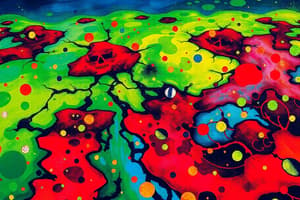Podcast
Questions and Answers
Eutrophication in aquatic ecosystems, often leading to hypoxic zones, is primarily exacerbated by which of the following intricate mechanisms?
Eutrophication in aquatic ecosystems, often leading to hypoxic zones, is primarily exacerbated by which of the following intricate mechanisms?
- Selective proliferation of certain phytoplankton species that produce allelochemicals, inhibiting the growth of other algae and leading to a monoculture vulnerable to sudden collapse.
- Upwelling of nutrient-rich waters from deep ocean layers, which is then further stimulated by excess chemical nutrients from agricultural runoff.
- Amplification of thermal stratification, preventing oxygen replenishment in deeper layers and concurrently diminishing nutrient upwelling from benthic zones.
- Synergistic interaction between excess nutrient influx and increased water turbidity, reducing photosynthetic activity while simultaneously enhancing microbial respiration rates. (correct)
In ex-situ bioremediation of contaminated soils, what is the MOST critical consideration regarding the 'prepared bed' used in land farming techniques?
In ex-situ bioremediation of contaminated soils, what is the MOST critical consideration regarding the 'prepared bed' used in land farming techniques?
- Maintaining an optimal moisture gradient and aeration profile through controlled irrigation and tilling to maximize microbial metabolic activity and contaminant bioavailability. (correct)
- Ensuring a high organic matter content derived from composted materials to foster a diverse and robust microbial community capable of degrading a wide array of contaminants.
- The integration of a layered system incorporating zeolites, activated carbon, and specific clay minerals to optimize contaminant adsorption and microbial colonization.
- The application of a synthetic polymer matrix to encapsulate contaminants, preventing leaching while providing a substrate for specialized microbial consortia.
How does bioaugmentation enhance the bioremediation process in heavily polluted sites, particularly those contaminated with recalcitrant compounds?
How does bioaugmentation enhance the bioremediation process in heavily polluted sites, particularly those contaminated with recalcitrant compounds?
- Through the application of specific enzyme cocktails that facilitate the breakdown of persistent pollutants, while strictly controlling pH and redox potential to optimize enzyme activity.
- By introducing genetically modified organisms (GMOs) capable of catabolizing complex pollutants, with the crucial step of assessing horizontal gene transfer risks to native microbial communities. (correct)
- By supplementing the indigenous microbial community with non-native but adapted microorganisms, carefully monitoring their competitive interactions and potential displacement of native species.
- Via the strategic addition of limiting nutrients and electron acceptors to stimulate the metabolic activity of existing microorganisms, thereby enhancing their capacity to degrade pollutants.
What is the paramount limitation of employing bioventing as an in-situ bioremediation technique for deep subsurface soil contamination?
What is the paramount limitation of employing bioventing as an in-situ bioremediation technique for deep subsurface soil contamination?
In the context of 'dead zones' formation, which intricate feedback mechanism most significantly amplifies the oxygen depletion process following an algal bloom?
In the context of 'dead zones' formation, which intricate feedback mechanism most significantly amplifies the oxygen depletion process following an algal bloom?
Considering the complexity of air pollution sources, what is the MOST significant challenge in accurately quantifying the impact of secondary pollutants like ozone (O3) and peroxyacetyl nitrate (PAN) on human respiratory health?
Considering the complexity of air pollution sources, what is the MOST significant challenge in accurately quantifying the impact of secondary pollutants like ozone (O3) and peroxyacetyl nitrate (PAN) on human respiratory health?
What intricate regulatory mechanism does the 'ASH TRACK Mobile App' primarily aim to optimize concerning the management of fly ash from thermal power plants?
What intricate regulatory mechanism does the 'ASH TRACK Mobile App' primarily aim to optimize concerning the management of fly ash from thermal power plants?
Which intricate aspect of fluoride pollution from industrial sources poses the GREATEST challenge for environmental remediation and ecological restoration?
Which intricate aspect of fluoride pollution from industrial sources poses the GREATEST challenge for environmental remediation and ecological restoration?
How does the presence of 'Acids and Alkalies' as water pollutants impact aquatic ecosystems beyond direct toxicity to organisms?
How does the presence of 'Acids and Alkalies' as water pollutants impact aquatic ecosystems beyond direct toxicity to organisms?
What intricate ecological consequence arises from the alteration of sediment biogeochemistry in aquatic environments contaminated with organic pollutants?
What intricate ecological consequence arises from the alteration of sediment biogeochemistry in aquatic environments contaminated with organic pollutants?
In the context of managing oil spills, what critical limitation hinders the effectiveness of chemical surfactants in dispersing oil slicks, particularly in cold marine environments?
In the context of managing oil spills, what critical limitation hinders the effectiveness of chemical surfactants in dispersing oil slicks, particularly in cold marine environments?
Which intricate biogeochemical process is MOST significantly affected by heavy metal pollution in aquatic sediments, leading to long-term ecological consequences?
Which intricate biogeochemical process is MOST significantly affected by heavy metal pollution in aquatic sediments, leading to long-term ecological consequences?
Considering the complexity of industrial wastewater discharges, what is the MOST significant challenge in effectively treating 'Pharmaceutical' pollutants?
Considering the complexity of industrial wastewater discharges, what is the MOST significant challenge in effectively treating 'Pharmaceutical' pollutants?
What critical factor determines the long-term ecological impact of 'Abandoned mines' as point sources of water pollution, particularly concerning acid mine drainage (AMD)?
What critical factor determines the long-term ecological impact of 'Abandoned mines' as point sources of water pollution, particularly concerning acid mine drainage (AMD)?
In the context of 'Natural sources of water pollution', what inherent limitation complicates efforts to mitigate the impact of soil erosion on water quality in riverine ecosystems?
In the context of 'Natural sources of water pollution', what inherent limitation complicates efforts to mitigate the impact of soil erosion on water quality in riverine ecosystems?
Given the intricacies of 'Marine Pollution', what presents the most formidable challenge in mitigating the ecological impact of navigational discharges of oil and detergents on marine ecosystems?
Given the intricacies of 'Marine Pollution', what presents the most formidable challenge in mitigating the ecological impact of navigational discharges of oil and detergents on marine ecosystems?
In the discussion of 'Water Pollution: Control Measures', what is the most critical constraint in implementing tertiary treatment processes for municipal wastewater, especially in developing nations?
In the discussion of 'Water Pollution: Control Measures', what is the most critical constraint in implementing tertiary treatment processes for municipal wastewater, especially in developing nations?
What intricate ecological mechanism underlies the disruption of marine life caused by oil and grease pollution in aquatic environments?
What intricate ecological mechanism underlies the disruption of marine life caused by oil and grease pollution in aquatic environments?
In the context of 'Air Pollution', what primary challenge complicates efforts to assess and mitigate the health impacts of particulate matter (PM2.5) in urban environments?
In the context of 'Air Pollution', what primary challenge complicates efforts to assess and mitigate the health impacts of particulate matter (PM2.5) in urban environments?
Considering the array of 'Sources of Air Pollution', what primary hurdle complicates the endeavor to mitigate indoor air pollution in developing countries?
Considering the array of 'Sources of Air Pollution', what primary hurdle complicates the endeavor to mitigate indoor air pollution in developing countries?
When considering primary pollutants, what poses the GREATEST challenge in mitigating the atmospheric impact of nitrogen oxides (NOx) emitted from mobile sources, especially in densely populated urban areas?
When considering primary pollutants, what poses the GREATEST challenge in mitigating the atmospheric impact of nitrogen oxides (NOx) emitted from mobile sources, especially in densely populated urban areas?
Considering 'Community waste water', what poses the MOST substantive obstacle in preventing the dispersion of contaminants of emerging concern (CECs) from municipal wastewater treatment plants into aquatic environments?
Considering 'Community waste water', what poses the MOST substantive obstacle in preventing the dispersion of contaminants of emerging concern (CECs) from municipal wastewater treatment plants into aquatic environments?
Considering the complexity of 'Industrial waste', what critical challenge complicates efforts to minimize the discharge of organic pollutants from pulp and paper mills into aquatic ecosystems?
Considering the complexity of 'Industrial waste', what critical challenge complicates efforts to minimize the discharge of organic pollutants from pulp and paper mills into aquatic ecosystems?
In the context of atmospheric aerosols, what intricate chemical process contributes to the formation of secondary organic aerosols (SOAs) and their subsequent impact on climate forcing?
In the context of atmospheric aerosols, what intricate chemical process contributes to the formation of secondary organic aerosols (SOAs) and their subsequent impact on climate forcing?
Considering the intricacies of air pollution meteorology, what atmospheric phenomenon presents the MOST significant challenge for air quality forecasting and management in mountainous regions?
Considering the intricacies of air pollution meteorology, what atmospheric phenomenon presents the MOST significant challenge for air quality forecasting and management in mountainous regions?
When considering the adverse effects of water pollutants, what represents the most complex hurdle in evaluating the true impact of 'Radioactive materials' on aquatic ecosystems and human health?
When considering the adverse effects of water pollutants, what represents the most complex hurdle in evaluating the true impact of 'Radioactive materials' on aquatic ecosystems and human health?
Considering 'types of sources of water pollution', what intrinsic factor hampers the efficient management of non-point source pollutants like agricultural runoff in large watersheds?
Considering 'types of sources of water pollution', what intrinsic factor hampers the efficient management of non-point source pollutants like agricultural runoff in large watersheds?
Flashcards
What are Dead Zones?
What are Dead Zones?
Areas in the ocean with very low oxygen concentration.
What causes Dead Zones?
What causes Dead Zones?
Excess chemical nutrients spurring algal growth.
What is Bioremediation?
What is Bioremediation?
Using microorganisms to degrade environmental contaminants into less toxic forms.
What is Bioventing?
What is Bioventing?
Signup and view all the flashcards
What is biosparging?
What is biosparging?
Signup and view all the flashcards
What is Bioaugmentation?
What is Bioaugmentation?
Signup and view all the flashcards
What is Ex-situ Bioremediation?
What is Ex-situ Bioremediation?
Signup and view all the flashcards
What is Land forming?
What is Land forming?
Signup and view all the flashcards
What are Bioreactors?
What are Bioreactors?
Signup and view all the flashcards
What is Composting?
What is Composting?
Signup and view all the flashcards
What is Air Pollution?
What is Air Pollution?
Signup and view all the flashcards
What are Primary Pollutants?
What are Primary Pollutants?
Signup and view all the flashcards
What are Secondary Pollutants?
What are Secondary Pollutants?
Signup and view all the flashcards
What characterises primary pollutants?
What characterises primary pollutants?
Signup and view all the flashcards
What forms secondary pollutants?
What forms secondary pollutants?
Signup and view all the flashcards
What are Quantitative Pollutants?
What are Quantitative Pollutants?
Signup and view all the flashcards
What are Qualitative Pollutants?
What are Qualitative Pollutants?
Signup and view all the flashcards
What are Biodegradable Pollutants?
What are Biodegradable Pollutants?
Signup and view all the flashcards
What are Non-biodegradable pollutants?
What are Non-biodegradable pollutants?
Signup and view all the flashcards
What is natural source of air pollution?
What is natural source of air pollution?
Signup and view all the flashcards
What is anthropogenic source of air pollution?
What is anthropogenic source of air pollution?
Signup and view all the flashcards
What are Particulate Pollutants?
What are Particulate Pollutants?
Signup and view all the flashcards
What is fly ash?
What is fly ash?
Signup and view all the flashcards
What is water pollution?
What is water pollution?
Signup and view all the flashcards
What are sources of pathogens?
What are sources of pathogens?
Signup and view all the flashcards
What causes organic water pollution?
What causes organic water pollution?
Signup and view all the flashcards
Study Notes
Dead Zones
- Dead zones, also known as biological deserts or hypoxic zones, are ocean areas with very low oxygen concentration, referred to as hypoxic conditions.
- They occur when excess chemical nutrients trigger algal blooms.
- These zones usually occur 200-800 meters below the surface, in the saltwater layer.
- Hypoxic zones can occur naturally due to the upwelling of excess nutrients.
- Dead zones are detrimental to animal life, and most of the animal life either dies or migrates.
- Human activity can create or enhance dead zones.
Bioremediation
- Bioremediation uses microorganisms (bacteria and fungi) to degrade environmental contaminants into less toxic forms.
- The microorganisms can be specifically designed for bioremediation with genetic engineering.
In Situ Bioremediation
- In situ bioremediation takes place at the contaminated site.
- Bioventing supplies nutrients through wells to contaminated soil to stimulate bacteria growth.
- Biosparging involves injecting air under pressure below the water table to increase groundwater oxygen and enhance contaminant degradation by bacteria.
- Bioaugmentation involves importing microorganisms to a contaminated site to enhance degradation.
Ex Situ Bioremediation
- Ex situ bioremediation involves removing the contaminated material for treatment elsewhere.
- Land farming consists of excavating contaminated soil, spreading it over a prepared bed, and tilling it periodically until pollutants are degraded.
- The goal is to stimulate indigenous biodegradative microorganisms and facilitate their aerobic degradation of contaminants.
- Bioreactors involve processing contaminated solid material (soil, sediment, sludge) or water through an engineered containment system.
- Composting uses nature's recycling of decomposed organic materials into compost.
Air Pollutants
- Air pollution refers to undesirable changes in the physical and chemical constituents of the air due to human activities.
Source of Air Pollutants
- Primary pollutants result from direct emission into the atmosphere (e.g., CO, SO₂, NOX, PM).
- Secondary pollutants result from reactions with atmospheric pollutants (e.g., Ozone, PAN).
Mode of Release
- Indoor pollutants come from cooking, smoking, air conditioning (e.g., CO, CO₂, VOCs).
- Outdoor pollutants come from industrial processes and transportation (e.g., PM, CO, VOCs).
Chemical Composition
- Particulate matter can be solid or liquid aerosols (e.g., PM2.5, PM10).
- Gaseous pollutants mix with air in vapor form (e.g., SOx, Ozone, NOx, CO).
Persistence
- Primary pollutants persist in their original form after being added to the environment (e.g., DDT, plastic).
- Secondary pollutants are formed by interactions among primary pollutants. An example is Peroxyacetyl Nitrate (PAN), formed by the interaction of nitrogen oxides and hydrocarbons.
Existence in Nature
- Quantitative pollutants occur in nature and become pollutants beyond a threshold level (e.g., Carbon Dioxide, Nitrogen Oxide).
- Qualitative pollutants are man-made and do not occur in nature (e.g., Fungicides, herbicides, DDT).
Biodegradability
- Biodegradable pollutants are waste products degraded by natural microbial action (e.g., sewage).
- Non-biodegradable pollutants do not decompose naturally or decompose slowly (e.g., plastics, polythene bags, DDT etc.).
Origin
- Natural pollutants are released during natural processes like volcanic eruptions and forest fires.
- Anthropogenic pollutants are released during human activities such as CO₂ emissions from burning fossil fuels.
Sources of Air Pollution
Natural Sources
- Ash from burning volcanoes.
- Dust from storms.
- Forest fires.
- Pollen grains from flowers in the air.
Human Sources
- Power stations using coal or crude oil release CO₂.
- Furnaces using coal, cattle dung cakes, firewood, kerosene.
- Steam engines in railways, steamers, motor vehicles give out CO₂.
- Motor and internal combustion engines running on petrol, diesel, kerosene.
- Vegetable oils, kerosene, and coal as household fuels.
- Sewers and domestic drains emanating foul gases.
- Emissions from agriculture, waste treatment, and biomass burning (stubble burning).
Particulate Pollutants
- Particulate pollutants are matter suspended in the air like dust and soot.
- Major sources of suspended particulate matter (SPM) include industries, vehicles, power plants, construction activities, oil refineries, railway yards, and marketplaces.
- PM10 are inhalable particles, with diameters generally 10 micrometers and smaller, coming from construction sites, pollen, or vehicle/industrial emissions.
- PM2.5 are fine inhalable particles, with diameters generally 2.5 micrometers and smaller, often from combustion processes.
- PM2.5 particles can penetrate deep into lungs and bloodstream, causing more severe health issues.
Fly Ash
- Fly ash is an end product of combustion during power generation in coal-based thermal power plants.
- It comprises silica, alumina, oxides of iron, calcium, magnesium, and toxic heavy metals.
- Uses of Fly Ash: manufacturing of Portland Cement, bricks/blocks/tiles, road embankment construction.
- ASH TRACK Mobile App was launched by the Ministry of Power for better management of fly ash, providing an interface between producers and users.
Fluorides
- Sources of fluorides: aluminum, steel, electrochemical plants, brick kilns, coal combustion, and glass etching factories.
- Volcanoes also release fluorides as gaseous and particulate pollutants.
- Fluoride particles settle on vegetation, burn tips of leaves, and cause fluorosis in cattle, resulting in loss of teeth, weight, and lameness.
Water Pollutants
Pathogens:
- Sources: Sewage, human and animal wastes, natural and urban runoff from land, industrial waste.
- Effects: Depletion of dissolved oxygen; foul odor; health effects (waterborne diseases).
Organic Pollutants:
- Sources: Automobile and machine waste, tanker spills, agricultural chemicals, industrial and household waste.
- Effects: Disruption of marine life, aesthetic damage, toxic effects, possible genetic defects and cancer.
Inorganic Pollutants:
- Sources: Agricultural runoff, mine drainage, industrial wastes, and urban runoff.
- Effects: Eutrophication, aesthetics, algal bloom, methemoglobinemia, and unfit water for use.
Radioactive Materials:
- Sources: Natural sources, uranium mining and processing, hospitals, and research labs.
- Effects: Cancer and genetic defects.
Heat:
- Source: Cooling water from industrial, nuclear, and thermal plants.
- Effects: Decreased solubility of oxygen and disrupted aquatic ecosystems.
Sediments:
- Source: Natural erosion, runoff from agricultural and construction sites.
- Effects: affects water quality and reduces fish populations.
Water Pollution Control Measures
- When wastewater is dumped into a river or stream, treatment involves sedimentation, coagulation, and filtration.
- This is primarily treatment.
- Water required for drinking undergoes secondary and tertiary treatments.
Primary Treatment
- Sedimentation allows pollutants to settle and move out.
- Coagulation combines fine particles and colloidal suspensions.
- Filtration filters suspended particles, flocculants, bacteria, and organisms.
- Total impurities collected are called sludge, and are used as fertilizer.
Secondary treatment
- Undesirable calcium and magnesium cations are removed.
- Soft water is exposed to air by forcing air through it for oxygen.
- This encourages bacterial decomposition of organic matter.
- Oxygen addition reduces carbon dioxide and sulfide.
Tertiary treatment
- Chlorine is used to kill bacteria.
- Other methods of disinfection are also used.
Oil Spill Cleanup
- Skimmers physically remove oil by separating it from the water.
- Sorbents absorb oil from the surface.
- Chemical surfactants can associate oil into smaller particles to accelerate their dispersion.
- Bioremediation agents such as microorganisms, like Paraperlucidibaca, Thalassolituus, can speed up natural biodegradation and help remove several classes of contaminants.
Heavy Metal Ions in Water
- Copper: fertilizers, tanning, and photovoltaic cells.
- Zinc: soldering, cosmetics, and pigments.
- Silver: refining of copper, gold, nickel, zinc, jewelry, and electroplating industries.
- Chromium: leather industry, tanning, and chrome plating industries.
- Arsenic: wooden electricity poles treated with arsenic, pesticides, fertilizers, oxidation of pyrite and arsenopyrite.
- Mercury: combustion of coal, municipal solid waste incineration, and volcanic emissions.
- Cadmium: paints, pigments, electroplated parts, batteries, plastics, rubber, photoconductors, and photovoltaics.
- Lead: PVC pipes, recycled PVC, lead paints, jewelry, lead batteries, and lunch boxes.
Agricultural Sources of Pollution
- Fertilizers consist of nitrogen, phosphorus, and potassium.
- Pesticides consist of chlorinated hydrocarbons, organophosphates, metallic salts, carbonates, and derivatives of acetic acid.
- Animal excreta, such as dung.
- Excess nitrate in drinking water reacts with hemoglobin to form non-functional methaemoglobin and impairs oxygen transport, called methemoglobinemia or blue baby syndrome.
Thermal Pollution
- Comes from thermal power plants and nuclear plants that release hot waters, decreasing dissolved oxygen in water.
Marine Pollution
- Includes coastal city sewage and garbage disposal and navigational discharge of oil, detergents, and radioactive waste.
Oil Spills
- Oil spills involve the uncontrolled release of crude oil, gasoline, fuel, or other oil byproducts into the atmosphere or water.
- They are a major environmental problem, chiefly from petroleum exploration and production intensified on continental shelves.
- Oil spills harm aquatic life by preventing sunlight from penetrating the surface and reducing dissolved oxygen.
- Oil toxicity comes from toxic compounds that can cause serious health problems, like heart damage, stunted growth, immune system effects, and even death.
- To clean up oil spills, oil booms (floating barriers) are used to stop the spreading of oil, which can then be retrieved.
Sources of Water Pollution
- Community wastewater includes discharges from houses, commercial, and industrial establishments and consists of human and animal excreta, food residues, cleaning agents, detergents, and other wastes.
- Industrial waste includes discharges of several inorganic and organic pollutants.
Types of Industries and Their Pollutants
- Mining: Chlorides, various metals, ferrous sulphate, sulphuric acid, hydrogen sulphide, ferric hydroxide, surface wash offs, suspended solids, chlorides, and heavy metals.
- Iron and Steel: Suspended solids, iron cyanide, thiocyanate, sulphides, oxides of copper, chromium, cadmium, and mercury; releases oil, phenol, and naphtha.
- Chemical Plants: various acids and alkalies, chlorides, sulphates, nitrates of metals, phosphorus, fluorine, silica, and suspended particles; releases aromatic compounds solvents, organic acids, and nitro compound dyes.
- Pharmaceutical: Releases proteins, carbohydrates, organic solvent intermediate products, drugs, and antibiotics.
- Soap and Detergent: Releases tertiary ammonium compounds and alkalies.
- Food processing: Releases highly putrescible organic matter and pathogens.
- Paper and Pulp: Releases sulphides and bleaching liquors, cellulose fibers, bark, wood sugars organic acids.
Types of Pollution
- The nature of pollution refers to any undesirable alteration in the physical, chemical, or biological attributes of air, land, water, or soil.
- Types of pollution include air pollution, noise pollution, water pollution, soil pollution, radioactive pollution, light pollution, or nitrogen pollution.
Water Pollution
- Water pollution is the presence of undesirable substances or pollutants in the water, such as organic, inorganic, biological, radiological, or heat, which degrade water quality so that it becomes unfit for use.
Sources
- Point sources are from a single, identifiable location.
- Non-point sources are from diffuse sources, including agricultural runoff, urban runoff, industrial waste water, and atmospheric deposition.
- Natural sources of water pollution include soil erosion and the leaching of minerals from rocks (due to natural solubility and solubility triggered by acid rain) and the decaying of organic matter.
Studying That Suits You
Use AI to generate personalized quizzes and flashcards to suit your learning preferences.




